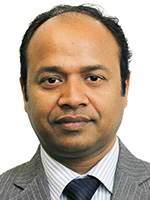
This issue’s question
“In these volatile uncertain times, how can treasurers become more entrepreneurial and help firms explore and capture new growth and investment opportunities?”

Mr Joseph Lee
Director of Global Treasury Advisory Services, Southeast Asia
Deloitte
The bread and butter issues, and the outcomes (for example improving business cash flow, capital effectiveness and efficiency, and margins) differentiating good from poor business operations have not shifted.
The shift is in the speed and magnitude of change in the different enablers that support effective business operations, and these factors have made staying afloat dicier.
Changes in the geo-political, business and regulatory environments, exacerbated by the rapid and frequent disruptions in technological advancements, have increased the urgency for business operations to act. It has become crucial for companies to have a strategic roadmap of how they would invest and deploy appropriate technology to make sense of the business environment, identify opportunities and manage results.
It seems like only yesterday that many companies shunned being the first adopters of technology for reasons such as fear of change, and fear of failure. Back then, the punitive costs of being an early adopter (be it financial or non-financial) were also prohibitive in many cases.
Today, technology options and delivery platform choices are aplenty, and they cater to different budgets, scale of operations and complexity. New systems, artificial intelligence (AI) and automated processes can increase the processing and analytical bandwidth of corporations and provide platforms for sizing up opportunities in the marketplace.
For the treasurer, the entrepreneurial push towards successful adoption of the right technology could free up valuable manpower that can then be deployed to identify new areas of market growth for the company, and to develop strategic/tactical plans to manage treasury risks. Treasurers can consider actioning a number of initiatives to help identify and manage growth and investing opportunities. They include treasury management systems to provide the organisation with visibility and transparency over its financial resources and commitments and risks associated with them that will need managing. Electronic dealing, confirmation and settlement is a value enhancing add-on that provides the straight-through process for funding and risk management operations while standardising trading operations. Adoption of BOTs and robotic processing applications (RPAs), meanwhile, can help increase efficiency in data gathering, reporting and analytics.
Firms can also look to leverage the scale and reach of core banking relationships to enhance support for existing business operations while providing outreach to new business areas in different geographies.
As with all investments in an organisation, it is imperative for the treasurer to build a credible and achievable business plan. A plan that has clear objectives, timelines, return on investment and payback period will improve the odds for management and business buy-in, and provide the financial and non-financial resources for the work ahead.
The journey of a thousand miles begins with a single step. The treasurer’s first step would be to take stock of where the organisation is and where it could be. The next steps following the assessment is where the treasurer’s business entrepreneurship comes in.

Anton Abraham
Head of International Advisory, Global Transaction Services
Bank of America Merrill Lynch
In order to help their organisations navigate today’s challenging macro conditions and shifting treasury landscape, treasurers need to be prepared to be more entrepreneurial. A key part of that is to leverage people, innovation and best of breed technology to find an incremental edge.
Technology in particular has moved from being an enabler to being a driver of change and, as the global marketplace changes, business models and operations need to adapt to remain competitive. This is especially true in Asia where the different markets, languages and regulations create a unique set of challenges.
We see three major areas that will impact a treasurer’s ability to be more entrepreneurial and help firms explore and capture new opportunities. On the technology front, building a coherent and optimised technology strategy is key but takes planning and foresight, a keen understanding of current technologies, and, more importantly, anticipating how technologies may evolve. Indeed “TreasuryTech” is now developing so quickly that not adopting new technology will negatively impact treasurers’ ability to manage risk, and capture opportunities. The real risk comes from not taking action in areas such as cloud for treasury applications, integration of multiple applications, management of master reference data and dashboard reporting applications.
Another big challenge for treasurers is leveraging data to identify emerging trends across global treasury operations, moving from reactive treasury management towards pro-active management across liquidity, financial risk management, investments, funding and working capital. Information harnessed from data provides treasurers with useful insights and enables them to optimise flows and capture new opportunities. Typically, we see treasurers focusing on data solutions related to cash flow forecasting, cash pooling, consolidated reporting, dashboards and real-time reporting. Even something as simple as automating the receipt of electronic bank statements can improve a treasurer’s visibility over their cash position and enhance efficiency.
More broadly, there is the need to embrace disruption: stand out treasuries seek to drive a revolutionary spirit within their own teams, encourage team members to challenge processes and ways of doing business with a focus on collaboration across the organisation. In order to disrupt and innovate in a rapid test-and-learn fashion, organisations should seek to partner with banks and other advisors to develop digital solutions that are globally consistent and locally relevant.
In addition to the above, treasurers also need to stay informed on a number of emerging technology areas even if their commercial applications are still evolving. These include distributed ledger technologies (blockchain, tokenisation) across areas such as payments, trade finance and working capital management; and AI going beyond robotic process automation into cognitive intelligence.
Underpinning all of this is of course one of the most important assets a treasury has – its people. People will be critical in driving change and partnering with the business to formulate a corporate wide approach to explore and capture new growth and investment opportunities.

Prem K Thakur
General Manager – Finance/Treasury
Sopra Steria
VUCA, short for volatility, uncertainty, complexity and ambiguity, is becoming a trendy managerial acronym and while it may be trying a little too hard to become just that, it does have the merit of pithily summing up the key challenges confronting treasurers.
In this VUCA world challenges and surprises for treasurers have become the norm and with an entrepreneurial mindset I believe we can also leverage them to yield opportunities and add value for our firms. In the VUCA world treasurers who are agile and smart enough to keep pace with the change can really help their organisations grab opportunities.
Treasury functions are often global and handle a substantial portion of a group’s worldwide balance sheet. One wrong decision or failure to act in a decisive and timely fashion can destroy a group’s profitability and undermine its status in the eye of investors.
As custodians of their company’s fund and shareholders’ interest, treasuries now, perhaps more than ever, need to act as an entrepreneur force within the organisation. As such the treasury teams can support the wider business by identifying opportunities for novel investments, acquisitions, and leveraging offshoring models more effectively.
The development of the VUCA world we now have to contend with can be traced back to the 2008 financial crisis, the subsequent Eurozone debt crisis and through to more recent economic events. All have contributed to challenges confronting treasurers today. Coupled with the rising cost of capital, governance and risk profiling treasurers’ responsibilities and strategic roles have been transformed significantly. Their unprecedented access to boardrooms nowadays is an indication of the scale of the transformation in their role.
In the VUCA world treasurers needs to move on from just dealing with numbers, finances and compliance to actively collaborating with the wider business to add value. As entrepreneurial treasurers, their remit is broader, more demanding and will almost certainly require the learning of new skills.
In adding value for the wider business, the entrepreneurial treasurer has to “enable, enhance and engender”. Ensuring visibility and control of cash positions; eliminating unproductive working capital; negotiating global funding lines with relationship banks/financial institutions; counterparty risk management; managing sovereign difficulties and associated regulatory uncertainty; and revising and applying improved corporate governance and policy control are among the key responsibilities.
Perhaps the biggest challenge though will be changing mindset with regards to technology. That means justifying to the wider group the need for investment in automation. It will also require keeping an eye on developments with AI and blockchain and upgrading technological skill set and know-how.
There is however no one way for developing treasury as an entrepreneurial force within an organisation. It can be accomplished in a variety of ways and to a variety of degrees, depending on how a corporate wishes to target its business segments.
Next question:
“Constantly changing regulations across the larger Asian markets present a big challenge for APAC treasurers. How do you manage to keep up to date with them consistently?”
Please send your comments and responses to qa@treasurytoday.com